The journey of women in space has been filled with incredible stories of perseverance, innovation, and groundbreaking achievements. From the early days of astronomy to the women who broke barriers to become astronauts, these pioneers have played crucial roles in advancing our understanding of the universe. This article explores nine captivating non-fiction books that highlight the contributions of women to space exploration. Whether it’s the skilled human computers at NASA, the unsung heroines behind the Hubble Space Telescope, or the remarkable women who dared to dream of spaceflight, these books offer inspiring and often overlooked narratives of the women who helped shape the history of space exploration.
Galaxy Girls: 50 Amazing Stories of Women in Space
by Libby Jackson
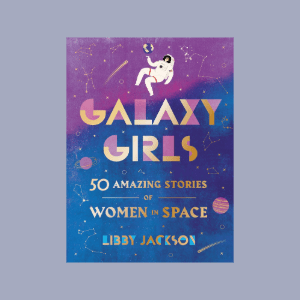
“Galaxy Girls” by Libby Jackson is a beautifully illustrated compendium that honors the incredible true stories of fifty inspirational women who have played pivotal roles in space exploration, from the 19th century to the present. This groundbreaking book highlights the contributions of figures like Mary Jackson and Katherine Johnson, who were key to NASA’s success, as well as Peggy Whitson, a record-holding astronaut. Spanning from Ada Lovelace’s early work in computing to the women behind the Apollo missions and those pushing the boundaries on the International Space Station and beyond, “Galaxy Girls” celebrates the often overlooked achievements of female astronauts, engineers, mathematicians, and scientists who have shaped humanity’s journey to the stars. With striking illustrations from students at the London College of Communication, this book inspires readers of all ages to reach for the cosmos.
The Six: The Untold Story of America’s First Women Astronauts
by Loren Grush
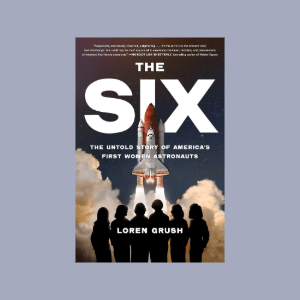
“The Six” by Loren Grush tells the compelling story of America’s first women astronauts, who broke barriers in a field long dominated by men. Selected from a pool of 8,000 candidates in 1978, these six extraordinary women—Sally Ride, Judy Resnik, Anna Fisher, Kathy Sullivan, Shannon Lucid, and Rhea Seddon—overcame significant challenges, including intense media scrutiny and rigorous training, to become pioneers in space exploration. Grush vividly captures their journey, highlighting their contributions to the space program and their lasting impact, with one member, Judy Resnik, tragically losing her life in the Challenger disaster.
Rise of the Rocket Girls
by Nathalia Holt
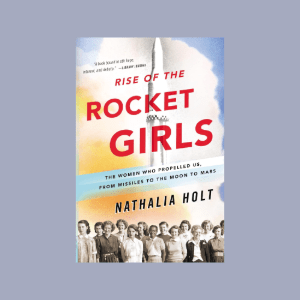
“Rise of the Rocket Girls” by Nathalia Holt tells the fascinating true story of the women who were instrumental in launching America into space during the 1940s and 50s. At a time when the Jet Propulsion Laboratory needed brilliant minds to calculate rocket trajectories and design, they turned not to men, but to a group of young women known as “human computers.” Armed only with pencil, paper, and exceptional mathematical skills, these women played a crucial role in developing rocket technology, leading to the first American satellites and the exploration of the solar system. Through extensive research and interviews, Holt brings to light the groundbreaking contributions of these women, offering a fresh perspective on their pivotal role in both the history of science and the future of space exploration.
Hidden Figures: The American Dream and the Untold Story of the Black Women Mathematicians Who Helped Win the Space Race
by Margot Lee Shetterly

“Hidden Figures” is the phenomenal true story of the black female mathematicians at NASA whose calculations were crucial to America’s greatest achievements in space. These exceptionally talented African American women, initially relegated to teaching in the segregated South, answered the call during WWII’s labor shortages, joining the Langley Memorial Aeronautical Laboratory. Despite working under Jim Crow laws, they played pivotal roles in America’s victories in the Cold War and the Space Race. This #1 New York Times bestseller chronicles the careers of Dorothy Vaughan, Mary Jackson, Katherine Johnson, and Christine Darden, highlighting their intellectual contributions and their fight against racial and gender barriers. Their story, the basis for an Academy Award-nominated film, is a powerful narrative of resilience, discrimination, and triumph in modern America.
Sally Ride: America’s First Woman in Space
by Lynn Sherr
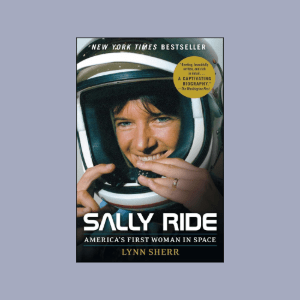
“Sally Ride: America’s First Woman in Space” by Lynn Sherr offers an in-depth look at America’s first woman in space, drawing from exclusive insights provided by Ride’s family, partner, and close associates. As a trailblazer in NASA’s first astronaut class to include women, Sally Ride shattered the barriers of a male-dominated field, inspiring generations of women by becoming the first American woman to journey into space. After her historic flights, she played a crucial role in investigating the Challenger and Columbia disasters, where she criticized NASA’s operational flaws. Beyond her space achievements, Ride was dedicated to promoting science education, especially for girls, through the company she co-founded. Sherr also delves into Ride’s closely guarded personal life, revealing the complexities of her private world with warmth and admiration. This biography brings to life a remarkable woman whose legacy continues to inspire.
The Glass Universe: How the Ladies of the Harvard Observatory Took the Measure of the Stars
By Dava Sobel
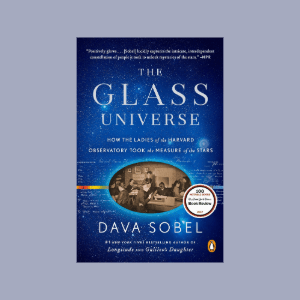
“The Glass Universe” by Dava Sobel is the captivating true story of the women who made groundbreaking contributions to astronomy in the mid-nineteenth century. Employed by the Harvard College Observatory as “human computers,” these women, initially family members of male astronomers and later graduates of women’s colleges, transitioned from calculating data to analyzing the stars captured on glass photographic plates. Their work led to major discoveries, including the composition of stars and the creation of a stellar classification system still used today. Sobel’s elegantly written book uncovers the hidden history of these pioneering women, whose efforts forever changed our understanding of the universe.
The Mercury 13: The True Story of Thirteen Women and the Dream of Space Flight
By Martha Ackmann

“The Mercury 13” by Martha Ackmann uncovers the little-known story of thirteen remarkable women who, in 1961, secretly trained and passed the same rigorous tests as NASA’s Mercury 7 astronauts, hoping to become America’s first female astronauts. Despite their exceptional qualifications, these pioneering women were dismissed by NASA and sidelined from the space race. While the USSR sent its first woman into space in 1963, it took the U.S. another twenty years to do the same. Ackmann’s book highlights the resilience and determination of these women, who went on to achieve extraordinary things despite their dreams of space flight being derailed. Through extensive interviews and never-before-seen photographs, “The Mercury 13” pays tribute to their courage and contributions to the space race and beyond.
Handprints on Hubble: An Astronaut’s Story of Invention
By Kathryn D. Sullivan
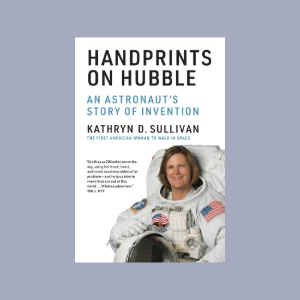
“Handprints on Hubble” by Kathryn Sullivan, the first American woman to walk in space, offers a firsthand account of her crucial role in the team that launched, repaired, and maintained the Hubble Space Telescope, which has dramatically expanded our understanding of the universe. Sullivan shares her journey from being a “Sputnik Baby” to becoming one of NASA’s first female astronauts. She vividly recounts her experiences, including the intensity of liftoff, the awe of spacewalking, and the challenges of addressing the shuttle program’s temporary grounding after the Challenger disaster. The book also details the innovative work behind Hubble’s maintainability, including the tools and processes that allowed NASA to correct a critical defect in the telescope’s mirrors. Through her story, Sullivan leaves both literal and metaphorical “handprints on Hubble,” celebrating the teamwork and ingenuity that made Hubble the most productive observatory ever built.
Right Stuff, Wrong Sex: America’s First Women in Space Program
By Margaret A. Weitekamp
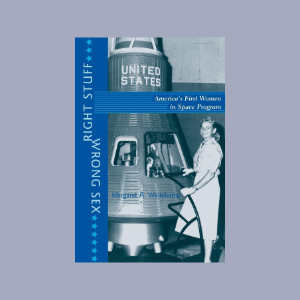
“Right Stuff, Wrong Sex” by Margaret Weitekamp delves into the overlooked story of the Woman in Space program, which, despite producing thirteen highly qualified female pilots in the early 1960s, failed to send an American woman into space until two decades later. The program, conceived by Dr. William Randolph Lovelace and funded by pilot Jacqueline Cochran, challenged the gender norms of the time, highlighting the capabilities of women in roles traditionally reserved for men. Weitekamp explores the experiences of the Fellow Lady Astronaut Trainees, documenting their achievements and the barriers they faced due to societal attitudes during the Cold War. Through extensive archival research and interviews, this book sheds light on a significant yet little-known chapter in the history of the U.S. space program and the broader women’s movement in America.
Why These Books Matter
These books matter because they bring to light the often overlooked contributions of women to space exploration and science, challenging the traditional, male-dominated narratives of history. By telling the stories of these remarkable women—astronauts, engineers, mathematicians, and scientists—they not only honor their achievements but also inspire future generations to pursue careers in STEM fields. These books underscore the importance of diversity in science and technology, showing that innovation thrives when different perspectives and talents are included. They also serve as a powerful reminder of the resilience and determination required to overcome societal barriers, making them essential reading for anyone interested in the true story of space exploration and the broader history of women’s contributions to science.



Leave a Reply